Nevada is a land built from contrasts — a desert of silence punctuated by cities that glitter like constellations brought to Earth. Travelers arrive expecting neon and spectacle, the Vegas of postcards and cinema, but what they find instead is a state of startling depth: valleys carved by ancient waters, mountain ranges that rise like walls of blue stone, high desert plains where sagebrush rolls in the wind, and towns where the frontier spirit feels remarkably unburied.
To move across Nevada is to trace the boundary between extremes — opulence and emptiness, feverish motion and vast stillness. It is a place where a person can stand alone beneath a billion stars and feel the size of the universe, then drive ninety minutes and sink into the thrum of a casino alive with possibility. The land itself seems to echo the gamble at Nevada’s heart: that life, like the desert, is unpredictable, sometimes unforgiving, and often astonishing.
Between its geothermal wonders, ghost towns, ski basins, canyons, lunar valleys, and living cities, Nevada is a state that rewards patience and curiosity. It is a place where you learn to look closer — past the mirage, into the truth beneath the shimmer.
Las Vegas: The Mirage in the Mojave
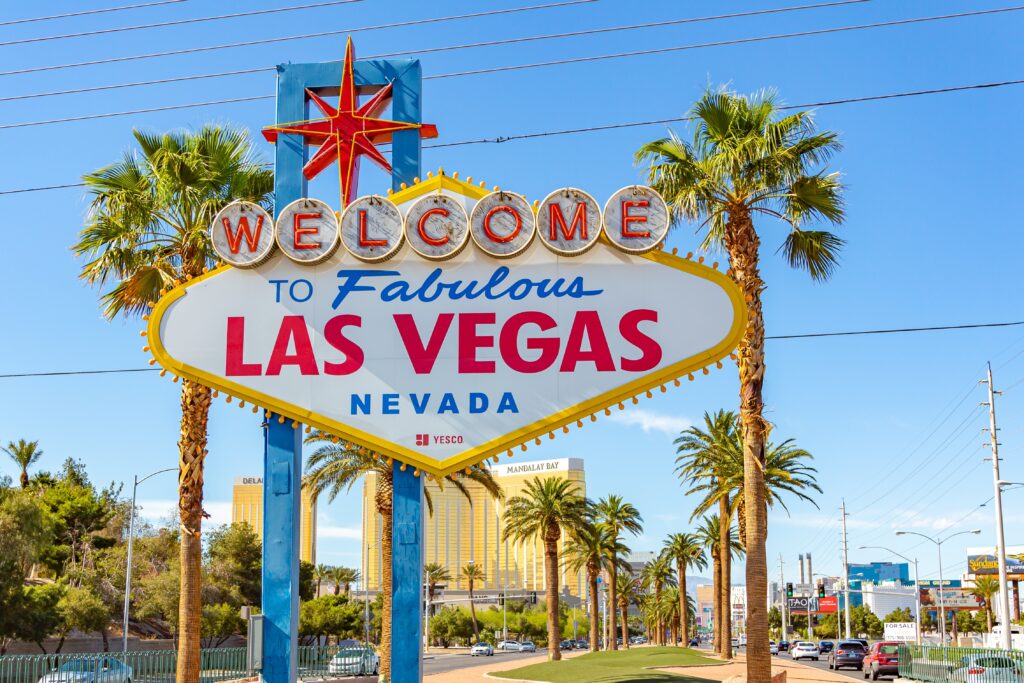
Las Vegas rises from the Mojave Desert like a shimmering mirage—a city that shouldn’t exist and yet thrives through sheer audacity. Its skyline glitters with neon ambition, each bulb radiating a promise: reinvention, escape, spectacle. But to understand Las Vegas, one must look beyond the casino carpets and high-limit rooms. This is a place where art, entertainment, cuisine, and architecture collide with a drama found nowhere else in America.
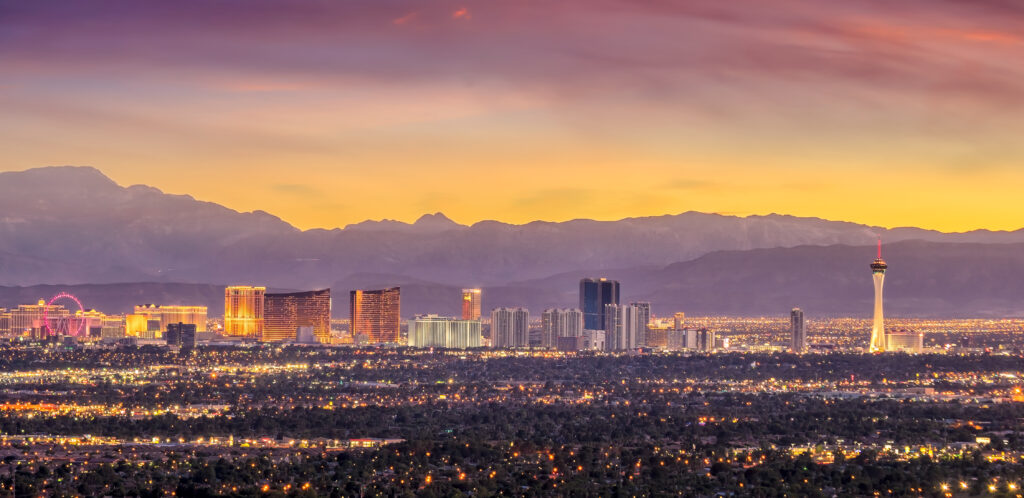
The Strip is a study in excess: fountains erupt skyward in choreographed arcs, pyramids glow with laser beams, Venetian canals ripple beneath faux Renaissance skies. Yet beneath this theatrical surface lies a remarkably human city. Chefs from Tokyo, Paris, and Mexico City deliver culinary pilgrimages in settings as elaborate as opera sets. Cirque du Soleil stages nightly acts of gravity-defying poetry. Museums—of neon, of natural history, of atomic testing—reveal the strange and storied past of the desert.

But venture off-Strip, and an entirely different Las Vegas emerges. The Arts District hums with murals, maker studios, and indie galleries housed in converted warehouses. Downtown’s Fremont Street echoes both old-school Vegas nostalgia and new creative energy. Meadows and mountains ring the valley, promising escape from the heat and noise—Red Rock Canyon is only minutes away, its sandstone walls burning gold at dusk.

Las Vegas is a contradiction made tangible: indulgent yet intimate, chaotic yet curated, synthetic yet deeply earnest in its desire to dazzle. It embraces its artifice openly, inviting visitors to step into an alternate reality for a few brief days. And in that transparency lies its magic—few cities celebrate imagination and possibility as brazenly as Las Vegas.
Reno: The Biggest Little City With a Big Western Soul
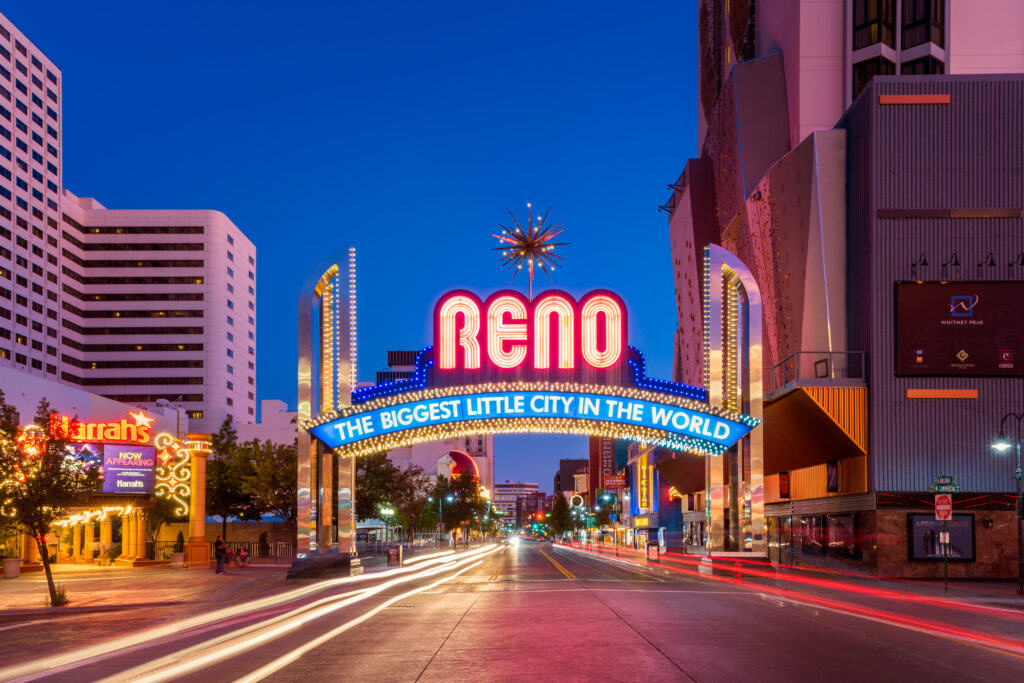
Reno lives in the shadow of its louder southern sibling, but it’s precisely this underestimation that makes it special. Once known primarily for neon-lit divorces, quick weddings, and gaming halls, Reno has reinvented itself as a creative, outdoorsy, entrepreneurial hub—yet without losing the gritty charm of its frontier heritage. It’s a place where a sculpture from Burning Man might sit across the street from a century-old casino; where craft breweries inhabit brick warehouses overlooking the Truckee River.
The river is Reno’s beating heart, flowing swift and cold from the Sierra Nevada. Its whitewater park draws kayakers and paddleboarders in summer, while shaded walking paths invite locals to linger at riverside cafés. Downtown’s revival unfolds around it: murals splash across walls, galleries host monthly art walks, and the beloved “BELIEVE” sculpture stands as a symbol of the city’s artistic identity.
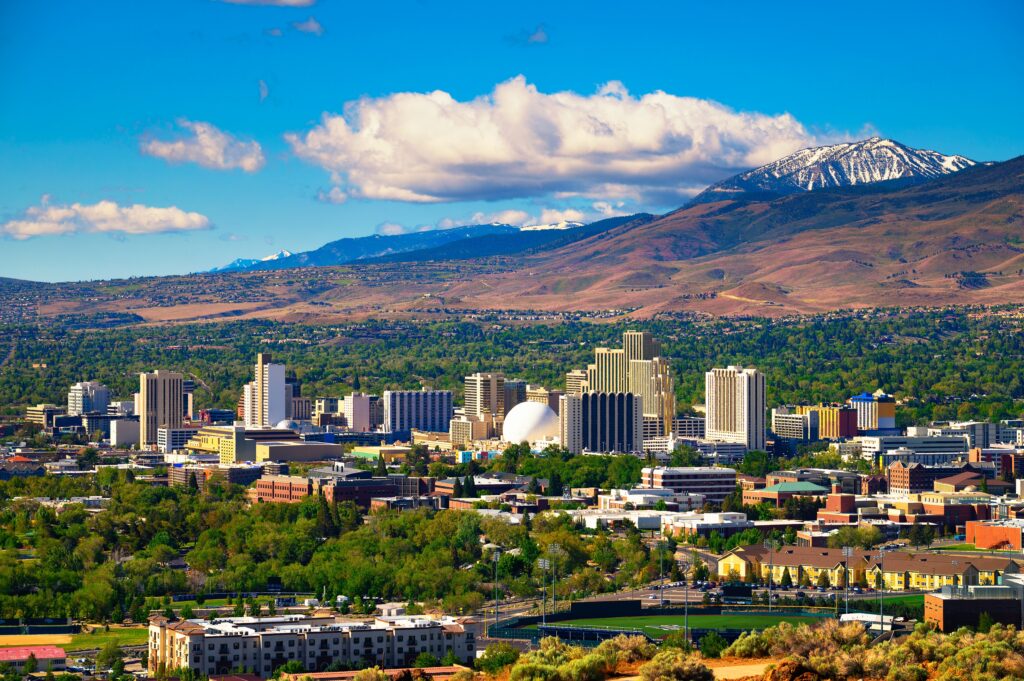
Just beyond the urban core, Reno becomes a gateway to the wild. Lake Tahoe is less than an hour away—a world of cobalt waters, granite peaks, and alpine forests offering skiing, hiking, and boating of the highest caliber. The surrounding high desert plains hum with sagebrush, wild horses, and endless blue sky. This easy access to nature is woven into Reno’s culture: gear shops, bike trails, and ski racks on cars are part of the city’s everyday rhythm.
Yet Reno never tries to hide its vintage edge. Classic casinos remain, glowing with nostalgia. Diners serve hearty Western breakfasts. Smoke-filled bars play blues late into the night. Old Reno and new Reno coexist not as rivals but as two layers of the same story.
Reno earns its moniker honestly: it is indeed a little city—walkable, approachable—but with a personality, a creativity, and a sense of place that feels far larger.
Lake Tahoe (Nevada Side): Sapphire Water, Granite Peaks, Endless Sky
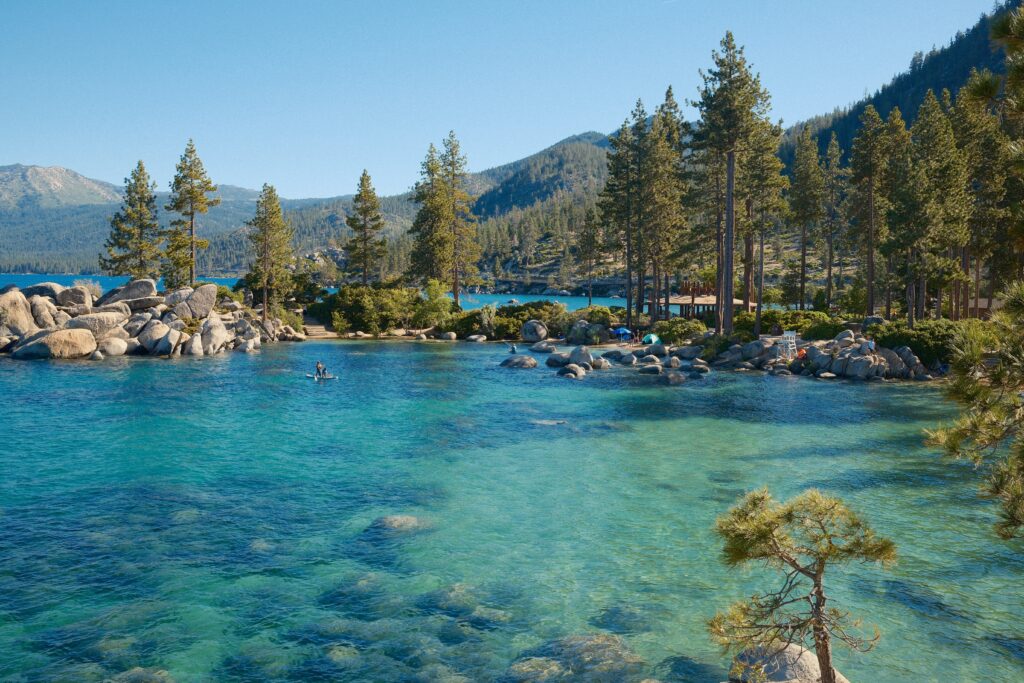
Lake Tahoe is a marvel that borders on myth—a vast alpine lake so clear that stones appear suspended beneath the surface, so blue that it seems to hold a piece of the sky within it. The Nevada side, less crowded than its California counterpart, blends rugged mountains, serene forests, and glittering casinos with an effortless grace that feels uniquely Nevadan. Here, wilderness meets understated luxury, and each season rewrites the landscape in its own palette.
In summer, Tahoe becomes a world of pure radiance. Paddleboarders glide across water like polished glass. Kayaks trace arcs of color over the lake’s sapphire surface. Trails lead through whispering pine forests to panoramic overlooks where the view seems impossibly vast—summits that cradle the lake like a gemstone set in granite. Hidden coves offer quiet respite, their boulder-strewn shores perfect for sunbathing or contemplative reflection.
Winter transforms the region into an alpine dreamscape. The ski resorts of Incline Village and Heavenly sparkle with powder, attracting skiers and snowboarders from far beyond the West Coast. Lakeside fireplaces crackle in elegant lodges. Snowsoft silence settles over the forest, broken only by the crunch of boots or the distant hum of a lift.
Yet what makes Tahoe truly magical is its dual nature. You can hike to a mountaintop in the morning, dine at a lakeside restaurant by afternoon, and end your night at a casino where laughter and music spill into the air. This seamless blend of wilderness, recreation, and entertainment is uniquely Nevadan.
Tahoe is not merely a destination—it’s a state of calm and awe. A place where the water seems to cleanse the mind, the mountains command reverence, and every sunrise glows cool and crystalline over one of the most beautiful lakes on Earth.
Carson City: A Capitol Rooted in Western Heritage

Carson City, Nevada’s capital, stands at the meeting point of high desert, pine-covered mountains, and living history. It may not boast the scale of other American capitals, but it offers something far rarer: authenticity. This is a city shaped not by political ambition but by frontier heritage, mining-era architecture, and the quiet dignity of a place that has endured through centuries of change.
Walking through Carson City feels like stepping into a Western narrative. Elegant stone buildings line the historic district, their 19th-century facades lovingly preserved. The Nevada State Capitol, with its silver-domed elegance and surrounding cottonwoods, remains one of the most inviting and approachable government buildings in the country. Museums—the Nevada State Museum, the Nevada State Railroad Museum—tell stories of silver booms, railroads, Native cultures, and the harsh realities of frontier survival.
But Carson City is not a relic; it’s a living, breathing community framed by natural beauty. The Carson Range rises sharply to the west, offering trails that climb through pine forests to sweeping vistas. The Carson River winds across the valley, a ribbon of green against the desert hues. Nearby ranches and foothills reflect the rhythms of rural Nevada—wide skies, open spaces, and a slower, more grounded pace of life.
Its location is enviable: Lake Tahoe lies minutes away; Reno is close enough to access easily but far enough to preserve the city’s serenity; Virginia City sits up the mountain like a time capsule. Carson City becomes a perfect base for exploring the state’s contrasting landscapes.
What sets Carson City apart is its sense of continuity. It honors its past without clinging to it, embraces modernity without losing character. It stands as a quiet reminder that not all capitals need grandeur—some shine through spirit, history, and the land that surrounds them.
A Living Ghost of the Silver Rush
Virginia City feels like history caught mid-stride—a town frozen in the era of bonanzas, brothels, miners, outlaws, and fortunes made or lost in a single afternoon. Perched high on the slopes of Mount Davidson, the town overlooks the desert basin like a watchful relic, its wooden sidewalks creaking under the weight of stories that refuse to fade.
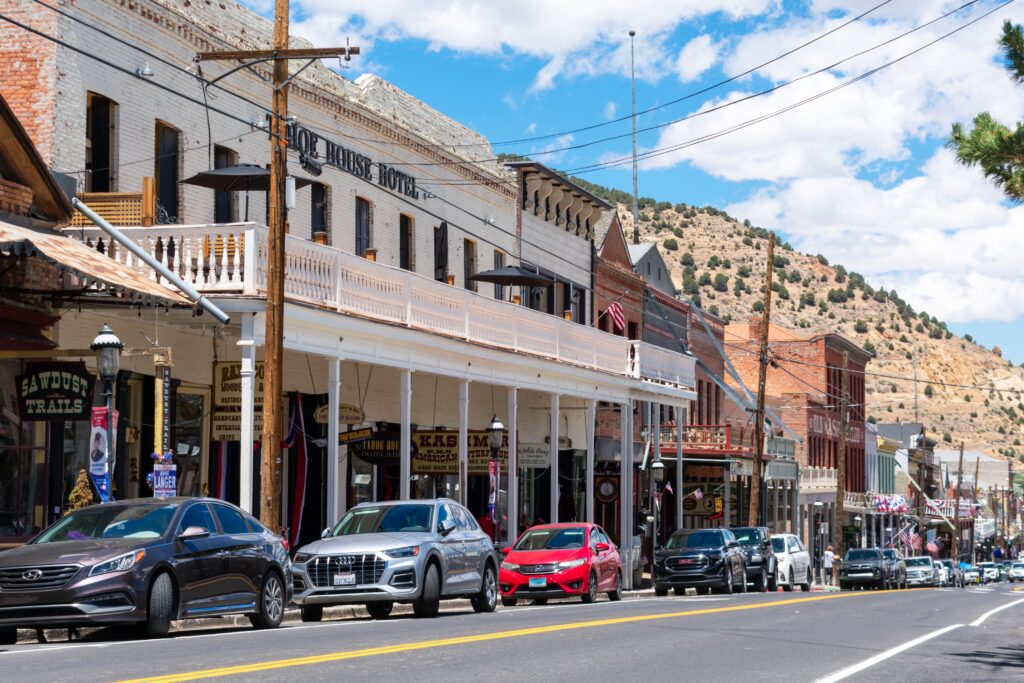
This is where the Comstock Lode was discovered, one of the richest silver deposits in American history. That discovery triggered a feverish boom that transformed Nevada and helped finance the growth of San Francisco. Today, Virginia City retains much of its 19th-century architecture, its saloons still swinging their doors, its storefronts offering glimpses of dusty pianos, antique bottles, and faded posters of long-gone spectacles.
Walking down C Street, the main thoroughfare, is like stepping into a sepia photograph: old hotels still stand, their balconies ornamented with ironwork; the boardwalks echo under boots; costumed interpreters reenact shootouts and retell tales of Mark Twain, who sharpened his wit here while writing for the Territorial Enterprise.
Yet beneath the theatrical charm lies genuine history. Mines plunge deep beneath the hills, some accessible via tours that descend into the dark, dripping earth where miners once labored by candlelight. Museums house ore carts, tools, and artifacts that reveal the dangers and ambitions of the frontier.
Surrounding hills glow with sagebrush and dust, offering viewpoints where time seems stretched thin. The wind carries faint mineral scents and the echo of forgotten days.
Virginia City is not merely preserved—it is performed, lived, breathed. It offers not a sanitized re-creation but an unvarnished immersion into the rough beauty of the Wild West. Few places in America allow visitors to feel the pulse of history so vividly under their feet.
Great Basin National Park: The Quiet Majesty of the Ancient West
Great Basin National Park feels like the most hidden national park in America—a place so quiet, so remote, that even silence seems to echo. Nestled near the Utah border, it is a sanctuary of starlight, solitude, and ancient wonders that reveal Nevada’s wild soul more intimately than any other landscape. Here, the desert meets alpine peaks in a sweeping collision of ecosystems, creating an environment both stark and sublime.
Towering above everything is Wheeler Peak, the state’s second-highest summit. Its limestone ramparts rise abruptly from the sagebrush plains, crowned by snowfields that linger into summer. Trails wind through groves of aspen and pine, climbing toward glacier-sculpted cirques and clear blue lakes that reflect the mountains like polished mirrors. Those who reach the summit are rewarded with vistas so vast they seem to stretch across half the continent.
But the park’s most mesmerizing treasures lie not above, but below. Lehman Caves, an underground cathedral carved by water and time, reveals stalactites shaped like straws, shields that resemble delicate disks, and rare formations found in only a handful of places on Earth. The caves feel otherworldly—cool, hushed, and lit in a way that reveals the earth’s inner architecture with reverence.
Night brings the park’s greatest spectacle: one of the darkest skies in the United States. The Milky Way is not a faint smear but a river of light pouring across the heavens. Constellations blaze sharper than they have for centuries in most cities. It is a place where stargazing becomes both spiritual and scientific, where visitors rediscover a sky that humans once knew intimately.
Great Basin is not flashy. It doesn’t demand attention. Instead, it rewards presence. It invites travelers to slow, breathe, listen, and remember that the American West still holds places where the world feels untouched, timeless, and profoundly alive.
Red Rock Canyon: Where Desert Stone Burns with Light
Red Rock Canyon is Las Vegas’s greatest secret—an oasis not of water but of geology and quietude. Just beyond the city’s neon glow, the Mojave Desert lifts itself into a circle of towering sandstone walls, their colors banded in crimson, gold, and white. The contrast is breathtaking: one minute you are surrounded by billboards and resorts, and the next you are standing before cliffs that seem to smolder with ancient fire.
The scenic loop road curves through this desert amphitheater, offering endless vistas of rugged peaks and valleys. But the true beauty of Red Rock is found along its trails. Paths meander between boulders the size of houses, ascend to wind-scoured overlooks, and slip into narrow canyons where the light softens to rose and amber. Climbers from around the world come to scale the rust-colored walls, their chalked hands tracing the sandstone’s hidden fractures.
Every moment here is ruled by light. Morning washes the cliffs in cool lavender tones. Noon ignites them into pure flame. Sunset sets the entire canyon ablaze, turning stone to molten copper. Even moonlight has its own magic—casting pale silver onto cactus spines and turning the desert floor into a dreamscape.
Red Rock Canyon is not empty; it is alive. Desert bighorn sheep cling to cliffs with impossible balance. Lizards dart among the rocks. Spring rains summon carpets of wildflowers that unfurl against the arid earth—yellow brittlebush, purple phacelia, and delicate apricot mallow.
For Las Vegas locals, Red Rock is a refuge. For travelers, it is an unexpected revelation: proof that the desert is not barren but vibrant, shifting, and endlessly expressive. It offers a quiet counterpoint to the city’s energy—a reminder that even in a place built on fantasy, nature holds the most awe-inspiring illusions of all.
Hoover Dam & Lake Mead: Engineering Triumph Meets Desert Vastness
Few structures in America feel as mythic as Hoover Dam, a monumental curve of concrete wedged between the black walls of Black Canyon. Completed during the Great Depression, it stands as a testament not only to engineering genius but to human resolve—an audacious attempt to tame the Colorado River and bring life to the desert Southwest. Standing atop the dam, one feels both dwarfed and exalted, as though witnessing the intersection of ambition and nature.
The dam’s Art Deco design—with its geometric patterns, monumental sculptures, and sunburst motifs—reflects the era’s optimism. Tours into its inner corridors reveal a world of humming turbines, industrial chambers, and cool stone passages that echo with history. Outside, the contrast between the dam’s immaculate curvature and the canyon’s jagged walls feels almost surreal.
Behind the dam stretches Lake Mead, one of America’s largest reservoirs and a shimmering expanse of blue amid red desert cliffs. Its waters provide recreation as well as life to the region. Boaters skim across the surface; kayakers explore inlets where silence prevails; swimmers drift in coves that feel a world away from the scorching desert heat.
Yet Lake Mead is also a reminder of the delicate balance of water in the West. Its fluctuating shoreline tells stories of drought, resilience, and humanity’s ongoing relationship with the land. The lake is not static; it mirrors the changing climate, the shifting demands of cities, and the eternal force of the Colorado River.
The entire region around Hoover Dam and Lake Mead feels like a border between worlds—human ingenuity on one side, undomesticated nature on the other. It is a place where visitors sense both the triumphs and limitations of our species. And above it all, the desert sky stretches wide and endless, watching over a marvel unlike anything else in North America.
Valley of Fire State Park: Nevada’s Fiery Crown Jewel
Valley of Fire is Nevada at its most dramatic—a landscape shaped by heat, time, and upheaval, where sandstone formations erupt in waves of scarlet, orange, and pink. Named for the way its rocks glow like embers at sunrise and sunset, the park feels almost extraterrestrial. Wind-sculpted arches, beehive-shaped mounds, and canyon walls etched with ancient petroglyphs create a world that blurs the line between geology and art.
The drive into the park is breathtaking: rock spires rise suddenly from desolate desert plains, their shapes twisted, towering, or impossibly balanced. Trails lead into this living gallery. Fire Wave, with its swirling red-and-white strata, resembles a frozen ocean of stone. White Domes offers slot canyons and cinematic scenery. Mouse’s Tank hides ancient rock carvings left by the Ancestral Puebloans, their symbols echoing across centuries.
Every turn reveals a palette of impossible color. When sunlight hits the red sandstone, the cliffs ignite; when clouds pass overhead, the rocks shift into deeper hues of rust and burgundy. Even the shadows seem alive, stretching across desert washes like liquid ink.
Wildlife thrives in this fiery world—desert bighorn sheep navigating cliffs with ease, ravens circling on thermals, lizards warming themselves on sunlit rocks. After rare rains, the valley erupts with spring blooms that carpet the terrain in desert marigold and primrose.
Valley of Fire is not simply beautiful; it is humbling. It speaks of geological epochs, civilizations long vanished, and the patient artistry of nature. Here, the desert reveals its most dramatic expression—raw, radiant, and unforgettable. To stand among these ancient formations is to feel small in the best possible way.
Death Valley (Nevada Approach): The Threshold Into the Void
Death Valley, approached from the Nevada side, feels like crossing into another dimension. The land becomes starker with every mile—mountains retreat into hazy silhouettes, salt flats shimmer like water, and heat rises from the earth in wavering veils. Yet despite its ominous name, Death Valley is intensely alive with color, texture, and story.
The Nevada approach offers a gradual descent into extremity. High desert plateaus roll into gravel plains; Joshua trees stretch their twisted limbs toward the sky; abandoned mining towns sit bleached by sun and silence. Then, suddenly, the valley opens—a vast bowl of earth so immense it seems to swallow the horizon.
At Zabriskie Point, the badlands ripple in gold and butterscotch waves, sculpted by eons of erosion. At Mesquite Flat, dunes shift with each windstorm, glowing peach at dawn and bronze at sunset. Badwater Basin, the lowest point in North America, spreads out in crystalline hexagons of salt—an otherworldly mosaic crunching underfoot.
But Death Valley’s beauty is not just visual. It is atmospheric. It surrounds you with heat that feels ancient, with silence that seems absolute, with distances that distort all sense of scale. The valley demands presence. It strips away distraction.
Wildlife survives through improbable resilience: sidewinder rattlesnakes carving S-shaped tracks in the sand, pupfish swimming in isolated springs, coyotes trotting across salt flats in the dim light of dawn. After rare storms, the desert blooms in sheets of yellow, purple, and white—a miracle of color in the harshest of environments.
Death Valley is a journey into extremes. It teaches humility, patience, and awe. It is a place where the world feels both eternal and ephemeral, where every footprint reminds you that nature, not humanity, writes the laws of survival here.
The Loneliest Road (U.S. 50): The Poetry of Distance
There is no drive in America like U.S. Highway 50 across Nevada—a stretch so vast and empty that it earned the moniker “The Loneliest Road in America.” Yet loneliness is the wrong word, for nothing about this journey feels abandoned. Instead, U.S. 50 is an ode to space—to sky that never ends, to valleys layered with sage, to mountain ranges arranged like vertebrae across the horizon.
The road unfolds in long, straight miles, broken every so often by a mountain pass where the land lifts briefly before spilling into another basin. Each valley feels distinct: some wide and sun-washed, others shadowed by storms drifting like dark ships through the sky. Windmills turn slowly in the distance. Wild horses graze in quiet herds, their silhouettes stark against the afternoon glare.
Small towns appear like mirages from another century—Ely, Eureka, Austin—each a collection of saloons, historic hotels, and weathered storefronts from the mining boom days. Travelers find themselves lingering in cafés and talking to locals who embody the timeless character of rural Nevada: independent, direct, and generous with stories.
Night on U.S. 50 is celestial theater. With no city lights for miles, the Milky Way cascades across the blackness like a river of crushed diamonds. Campfires crackle in quiet roadside pullouts, and the silence is profound, interrupted only by the whisper of wind in the sagebrush.
The Loneliest Road is not lonely at all. It is absorption. It is discovery. It is the realization that empty spaces are not voids but the truest expressions of the American West.
Alien Country and the Extraterrestrial Highway: A Mythic Desert of Secrets
The desert between Alamo and Tonopah is vast enough to hold secrets—and for decades, it has. This is the land of whispered stories, shimmering heat mirages, and a sky so wide that anything feels possible. Along Nevada State Route 375, officially named the Extraterrestrial Highway, landscape and legend blend seamlessly.
The road moves through a realm of open desert basins, framed by sawtooth mountains. Sunlight glints off distant quartz outcrops. Dust devils spiral across empty plains. And somewhere beyond the restricted fences and warning signs lies the most famous military secret in America: Area 51.
While visitors cannot glimpse the base itself, the atmosphere is charged with mystery. Little towns lean into the mythology—Rachel, home of the quirky Little A’Le’Inn, displays alien murals and stories from travelers who swear they’ve seen lights darting across the night sky. Some come to chase UFO sightings; others simply revel in the surreal stillness of the desert.
But beneath the pop-culture charm lies a landscape of striking beauty. The desert at dusk glows lavender and rose, the mountains shifting into deep blue silhouettes. At night, stars feel uncannily close, as if the universe itself were leaning in. Satellites glide silently overhead, and the quiet suggests that the boundary between Earth and the unknown is thinner here.
The Extraterrestrial Highway captures Nevada’s ability to be both myth and reality—an expanse where imagination thrives, where stories grow, and where each traveler becomes part of the desert’s ongoing mystery.
The Mojave’s Southern Frontier: Gold Mines, Ghost Towns, and the Edge of Forever
In Nevada’s southern reaches, where the Mojave Desert stretches toward California and Arizona, the land becomes a tapestry of gold-colored hills, abandoned townsites, and sun-baked silence. This region once thrummed with mining towns founded on dreams of fortune—Searchlight, Nipton (on the border), Nelson, Goodsprings—many now reduced to clusters of shacks leaning into the wind.
Yet these ghost towns are not ruined; they are preserved by emptiness. Splintered wooden saloons, rusted stamp mills, and hand-dug mine shafts lie scattered among creosote bushes and yucca. Each building feels like a page torn from Nevada’s boom-and-bust epic.
Nelson Ghost Town is among the most evocative—an open-air museum of weathered barns, classic cars, vintage signs, and mining relics. The surrounding El Dorado Canyon, its cliffs glowing golden-orange in the sun, conceals the remnants of some of the most lucrative gold mines in the state.
To the west, Goodsprings cradles the Pioneer Saloon, one of Nevada’s most legendary bars, where bullet holes in the walls and historic photographs tell stories that walk the fine line between truth and folklore.
But the land itself is the star. Here, Joshua trees stand twisted like dancers frozen mid-motion. Red mountains rise in layered strata. In spring, desert marigold paints the sand in bright yellow bursts. The Mojave wind moves constantly, whispering through empty doorframes and shifting small drifts of sand across forgotten roads.
This is the Nevada that feels eternal—the one shaped by heat, isolation, and dreams. The one that asks nothing of travelers but openness. The one that leaves you with a feeling of stepping briefly into the past, and into the endlessness of the West.
Pyramid Lake: Sacred Waters and Desert Silence
Pyramid Lake is not merely a lake—it is an emotional experience, a place where silence feels ancient and the landscape appears sculpted by memory rather than geology. This vast inland sea, held within the Paiute Reservation, lies like a shard of deep blue glass on the desert floor, bordered by volcanic formations and rolling sagebrush plains. Even from a distance, the lake’s surface gleams with an inner luminosity, shifting from turquoise to cobalt depending on the light.
The lake’s defining features—Anaho Island, home to colonies of pelicans, and the pyramid-shaped tufa formations rising from the water—make the shoreline feel almost mythic. Tufa towers, formed by ancient mineral deposits, stand like stone sentinels under an enormous sky. The wind moves gently across the water, and the air often carries the soft smell of minerals and desert dust.
Here, history and spirituality intertwine. Pyramid Lake is central to the culture of the Pyramid Lake Paiute Tribe, and its stories, passed through generations, give the space an added depth. The tribe protects its land with care, and every visitor senses the dignity and reverence of the place.
Fishing at Pyramid Lake is legendary—mammoth Lahontan cutthroat trout glide through deep waters, drawing anglers from around the world. But beyond sport, there is a meditative quality to being here. The desert horizon bends toward infinity, and time seems to flatten into a single, tranquil moment.
At sunset, the lake glows with surreal color. The sky melts into pinks, oranges, and indigos, reflecting on water so still it becomes a mirror. Pyramid Lake is one of Nevada’s greatest quiet spaces—a reminder that beauty often thrives far from crowds, in places shaped by wind, water, and centuries of stillness.
Tonopah and the Forgotten Center: Stars, History, and the High Desert Night
Tonopah sits at the crossroads of Nevada’s central desert—remote, wind-swept, and surprisingly magnetic. It was once one of the richest mining towns in the West, born overnight in 1900 when prospector Jim Butler discovered silver-rich ore in the barren hills. Today, Tonopah feels half-ghost town, half-living museum, but wholly alive with atmosphere.
The Tonopah Historic Mining Park sprawls across the hillside, a labyrinth of wooden headframes, rusting machinery, and tunnels where miners once traveled hundreds of feet underground. Walking the park is like stepping into the early 1900s: the clang of pickaxes still seems to echo between timbers, and the scent of dust and engine oil lingers in the hot air.
Downtown, the Mizpah Hotel remains the grand dame of the desert—an ornate, red-brick beauty with velvet furnishings, creaking stairways, and a reputation for ghostly guests. Whether haunted or not, the hotel radiates old-world charm and offers a rare sense of stepping back in time while enjoying modern comforts.
But Tonopah’s greatest treasure lies above. This region holds some of the darkest night skies in the continental United States, designated as a Gold Tier International Dark Sky Site. The Milky Way spills across the night with breathtaking clarity, and constellations usually invisible become bright enough to trace by hand.
Standing outside the town limits under the desert night is transformative. Coyotes yip somewhere beyond the sagebrush. A breeze whispers over the gravel. The universe reveals itself in silence and splendor.
Tonopah is the heart of Nevada’s forgotten interior—a place where time stretches out, where history whispers under your feet, and where the night sky opens into eternity.
Mount Charleston: The Alpine Crown Above the Desert
Rising nearly 12,000 feet above the Mojave, Mount Charleston feels like a different world entirely—an island of alpine coolness floating above the desert heat of Las Vegas. As you ascend from the valley, Joshua trees give way to piñon pines, then to stands of tall ponderosa and aspen. By the time you reach the upper elevations, the air is crisp, scented with resin, and alive with birdsong.
At the heart of the Spring Mountains National Recreation Area, Mount Charleston offers a rare blend of high-country wilderness and accessibility. Locals retreat here in summer to escape the heat; in winter, the peaks turn sparkling white, drawing snowshoers and skiers to Lee Canyon. The contrast is astonishing—ski slopes just 45 minutes from the Las Vegas Strip.
Trails wind through forests alive with mule deer and mountain bluebirds. The Cathedral Rock Trail offers sweeping views without strenuous climbing, while the South Loop Trail leads to Charleston Peak, one of the highest summits in Nevada. The final ridge walk, surrounded by thin air and pale stone, feels like walking the spine of the world.
But Mount Charleston is more than scenery—it’s an ecological sanctuary. Rare species such as the Bristlecone pines thrive here, their twisted trunks testifying to centuries of survival. In autumn, the aspen groves explode into gold, drawing photographers and dreamers who wander the forest in soft afternoon light.
Mount Charleston is a blessing for Nevada—a reminder that the state’s beauty is diverse, layered, and full of surprises. A mountain oasis, an alpine refuge, and a promise that even in a desert, cool winds and vast forests can flourish.
Laughlin: The River City of Desert Sun
On the far southern edge of Nevada, where the state tapers toward Arizona and California, Laughlin gleams like a polished gem along the Colorado River. Founded only in the 1960s, it feels both modern and timeless—an oasis of shimmering water, casino towers, and palm-lined walkways carved into rugged desert hills.
The Colorado River is Laughlin’s lifeblood. It moves with clarity and purpose, its cool waters flowing between tawny mountains and shimmering beaches. Jet skis dart across the surface, kayaks glide through glassy stretches, and river cruises drift lazily past cottonwoods and bathers sunning on the shore. The riverfront promenade hums with music, laughter, and the clink of glasses from outdoor patios.
Casinos line the banks—sleek, bright, and energetic—but Laughlin feels gentler than Las Vegas. The pace is unhurried. Families stroll the waterfront. Retirees lounge by pool decks. The desert sky opens wide overhead, unbroken by neon towers.
Just beyond town, the landscape shifts into raw, expressive desert. Katherine Landing offers boat launches and sandy coves; Lake Mohave stretches north in long blue corridors between volcanic cliffs. At sunset, the mountains glow deep purple, and the river reflects the last light like a polished mirror.
To the west, the Grapevine Canyon petroglyphs tell stories hundreds, perhaps thousands, of years old—spirals, figures, and symbols carved by ancient peoples. And to the south, the desert rolls into quiet washes filled with creosote, wild burros, and the soft whisper of wind.
Laughlin is Nevada in balance: sun-splashed, carefree, connected to the water that shaped the West, yet surrounded by the great stillness of open desert.
Black Rock Desert – Where Silence Becomes a Landscape
There are places in Nevada where the world seems to pull inward, becoming vast in its emptiness and strangely intimate at the same time. The Black Rock Desert is one of them. Stretching across an ancient lakebed in the far northwest of the state, it is a place where distance becomes abstract, the horizon a hard line drawn in light, and sound falls away until only the faint hiss of wind over the playa remains. The first thing you feel here is space — not as an idea, but as a physical force.
The famous Black Rock Playa, flat as a sheet of hammered copper, is so wide and unbroken that objects appear to float above the earth. Sunsets spill across it in streaks of ember and rose; at night, stars gather in numbers so dense they resemble dust. This is the stage upon which Burning Man briefly rises every year, transforming silence into a surreal city of fire, art, and imagination. But once the festival dissolves, the playa returns to its natural self: austere, lunar, a place that resists claiming anything except time.
Venture beyond the playa and you’ll find other worlds: the Granite Range, sharp and rugged; the smoke-scented hot springs like Black Rock and Trego, where steam curls into cold desert air; and the migrating wildlife that moves like flickers of life in a place that seems uninhabitable. This desert reminds you that Nevada is not simply a land of casinos and neon — it is a kingdom of geological drama.
To visit the Black Rock Desert is to surrender to scale. Here, solitude is not loneliness but clarity, and the empty spaces seem to expand your thoughts until they echo the land itself: wide, bare, honest.
Elko & the Ruby Mountains – Nevada’s Alpine Surprise
In northeastern Nevada, far from the glamour of the south or the mining bones of the west, lies Elko, a town that feels like a frontier outpost surrounded not by dust but by mountains so unexpectedly lush they challenge every assumption you might have about the Great Basin. This is the gateway to the Ruby Mountains, one of the most astonishing and least-known alpine ranges in the United States — a place where glacial valleys carve deep scars, where waterfalls tumble off red peaks, and where the desert suddenly breaks open into something almost Swiss.
Elko itself carries an earthy authenticity shaped by ranching, Basque heritage, and the persistent spirit of people who make their lives in wide-open places. The annual National Cowboy Poetry Gathering transforms the town into a celebration of stories, songs, and big-sky traditions, reminding visitors that Nevada’s culture is rooted far more deeply than many imagine.
Yet it is the Rubies that define the region. Drive Lamoille Canyon, and you enter a cathedral carved of granite: high walls rising abruptly, glacial bowls shimmering in light, stands of quaking aspens painting the slopes gold in autumn. In summer, wildflowers scatter the meadows in color; in winter, the canyon becomes a frozen sanctuary, and backcountry skiers trace new lines on untouched snow.
At the top of the range lies Liberty Pass, which opens onto a string of alpine lakes so quiet they seem to hold their breath. The valleys — Thomas Canyon, Island Lake, Dollar Lakes — feel like portals into a hidden version of Nevada, one green and cold and utterly alive.
Elko and the Ruby Mountains are a reminder that Nevada contains multitudes: desert and snow, ranch and refuge, tradition and wilderness, all meeting where the mountains rise.
The Carson Valley – Pastures Beneath the Mountains
South of Carson City, where the Sierra Nevada begins its rise in earnest, lies the Carson Valley — a broad, pastoral sweep of ranchland framed by mountains that seem impossibly steep when viewed from the valley floor. This is one of Nevada’s oldest settled regions, a place where the scent of sagebrush mingles with irrigated hay fields, where barns stand like weathered monuments, and where history is woven into the land.
Towns like Minden, Gardnerville, and Genoa retain an old-world charm. Genoa, the oldest settlement in Nevada, feels like a frontier town caught in a moment of golden afternoon: quiet streets, historic buildings, cottonwoods rustling in the breeze. Ranching culture still shapes the valley’s rhythm — cattle drives, local rodeos, and families who have worked the land for generations.
The backdrop to it all is the Sierra, rising abruptly in a wall of granite and snow. At their feet runs the Carson River, winding through cottonwood groves and wetlands where migratory birds turn the sky into motion. The valley’s light is extraordinary: soft and milky at dawn, warm and sweeping at sunset, when alpenglow turns the mountains rose-colored.
Nature lovers drift toward Jobs Peak, whose unmistakable triangular silhouette rules the skyline, while hot-air balloons drift silently over fields in the early morning. In autumn, the trees ignite in gold along the riverside; in winter, storms sweep over the Sierra, leaving the valley crisp and silver.
The Carson Valley offers a peaceful contrast to Nevada’s louder landscapes — a reminder that the state is not only desert and spectacle but also agriculture, heritage, and quiet beauty.

